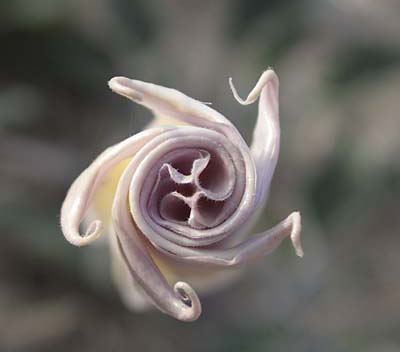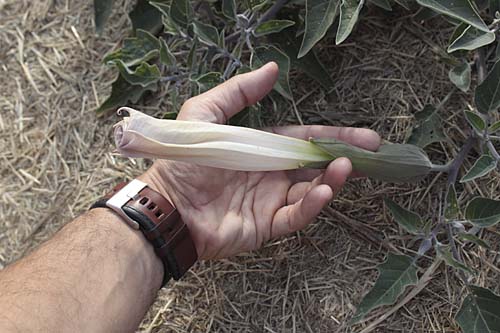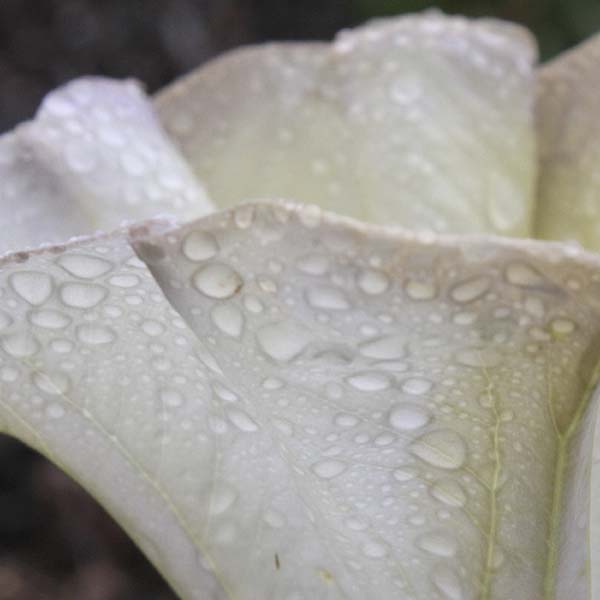In the local canyons, this time of year brings about the spectacular flowers of the sacred datura, Datura wrightii. The low, mounding bushes grow two to three feet tall and easily twice as wide, and are covered from dusk to mid-morning with immense white trumpets, easily eight inches across, often flushed with pale lavender.
 Photo by Dlarsen, via Wikimedia Commons [ source ]
Photo by Dlarsen, via Wikimedia Commons [ source ]
This is one of several species of the genus that has been called toloache in Mexico. It’s in the nightshade family, and like other members of the genus Datura, the plant is as toxic as it is spectacular.
Even though it’s highly poisonous, some Native Americans used the plant as part of a ceremony marking the passage of a child to an adult. From the Wikipedia: “Among the Chumash, when a boy was 8 years old, his mother gave him a preparation of momoy to drink. This was supposed to be a spiritual challenge to the boy to help him develop the spiritual wellbeing that is required to become a man. Not all of the boys survived [my emphasis].”
 On my recent pre-dusk hike through our local Los Peñasquitos Canyon Preserve all the buds on the numerous toloache plants were tightly furled when I arrived.
On my recent pre-dusk hike through our local Los Peñasquitos Canyon Preserve all the buds on the numerous toloache plants were tightly furled when I arrived.
 But by the time I left, less a half hour before sunset, the flowers buds were loosening. Had I stayed an hour longer I would have been able to view the fresh flowers in the last glow of daylight like an intoxicating evil welcoming the night.
But by the time I left, less a half hour before sunset, the flowers buds were loosening. Had I stayed an hour longer I would have been able to view the fresh flowers in the last glow of daylight like an intoxicating evil welcoming the night.
 Here you can get a sense for how large these flowers will be.
Here you can get a sense for how large these flowers will be.
Despite its bad press this is one of our local plants that I’ve been eying to add to the garden. The only thing the cat shows any interest in are plants that look like grasses or catnip, and there are parts of the yard no small child could get to. Besides, I’ve already got a number of toxic plants in the garden–oleanders, tomatoes and other nightshade cousins.
In addition to having amazing flowers, this datura requires no added water during the long dry summer. Nothing this spectacular can make that claim.
Speaking of poisonous plants, last week’s New York Times had an article on the Duchess of Northumberland. She’s in the process of building a modern annex to grounds that were designed by Capability Brown, the landmark British landscape designer from the eighteenth century. Traditionalists are not happy. “They said I am to gardens what Imelda Marcos is to shoes,” the Duchess is quoted. In her project one of the features is the Poison Garden, which the article describes as “a spooky fenced-off area with about 100 varieties of toxic plants, as well as cannabis and opium poppies.”
I bet this duchess’s garden parties will be pretty interesting affairs…







 Photo by Dlarsen, via Wikimedia Commons [
Photo by Dlarsen, via Wikimedia Commons [ 

